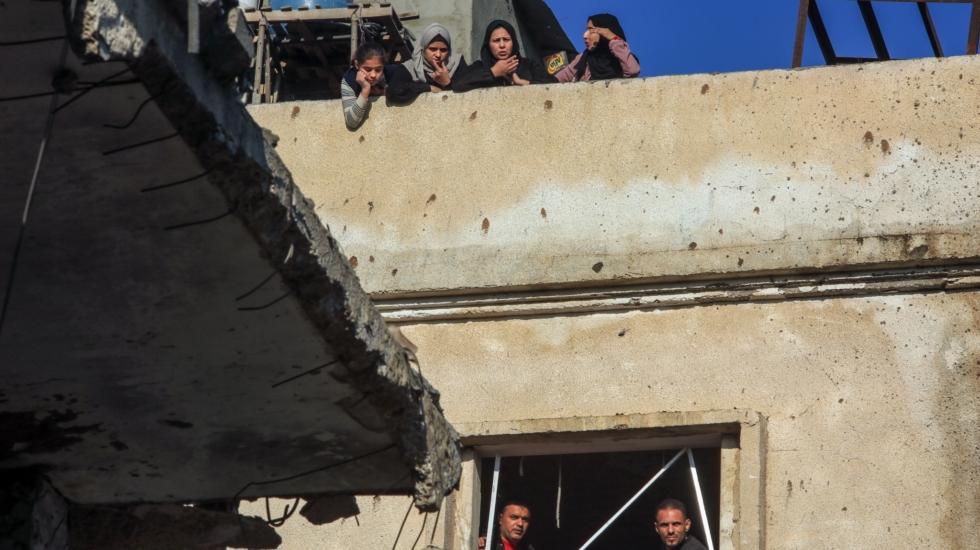

Neighbors inspect the damage caused by Israeli bombing in the Gaza Strip.
After more than 70 days of continuous bombing and a staggering death toll, we are struggling to find the words to describe the situation in A loop. We talked about an unprecedented emergency, crisis and humanitarian catastrophe. But all words are not enough to explain the reality in the Gaza Strip. Perhaps the only thing that is even close is hell. Gaza is hell.
Much of Gaza’s population was forcibly moved to the southern part of the strip, where they were promised safety but never found it. Now 85% of the population is displaced in less than a third of the territory. A territory which, we recall, was already among the most densely populated areas on the planet. This means RafahIn the south of the country, where most of the displaced are concentrated, the number of residents quadrupled overnight. The area was also already one of the poorest and lacks the infrastructure and resources needed to support such a population. This is not a place that can accommodate more than a million people, much less the entire Gaza Strip.
They have nowhere to go, they live on the streets in the cold, in the mud and in the rain. Everywhere you look there are plenty of makeshift shelters.
Families of internally displaced persons live in inhumane conditions. Those lucky enough, especially now that winter has set in, are sheltering inside UNRWA premises, in tiny rooms separated by blankets. But the rest have nowhere to go, they live in nature, in the cold, in the mud and in the rain. Everywhere you look there are plenty of makeshift shelters.
The areas around UNRWA buildings are crowded with shelters and desperate, hungry people.
The situation inside the shelters is not much better. Overcrowding is such that hundreds of people share one bathroom and one shower.. We have been seeing a rapid increase in diarrhea cases for several weeks now. Hepatitis begins to appear. Many skin diseases also occur due to poor hygiene conditions.
Moreover, even in these shelters people are not safe. Because we never tire of repeating that there is no safe place in Gaza. Not in the north, not in the south, not even in places like schools, hospitals or UN sites. In fact, our facilities, many of which are shelters for displaced people, have been hit directly or indirectly more than 150 times, even though we continue to share the coordinates of all of them with the Israeli army.
Our facilities, many of which are shelters for displaced people, have been hit directly or indirectly more than 150 times.
Humanitarian aid as a weapon of war
Hunger is becoming as deadly a threat as bombs. Every time we meet more and more people who have not eaten for one, two or three days.
Food, water and fuel are systematically used as weapons of war. Humanitarian agencies are forced to beg for humanitarian aid that is not enough to cover the enormous needs of the population.
Humanitarian agencies are forced to beg for humanitarian aid that is in short supply
UNRWA is the largest humanitarian operation in Gaza, with more than 5,000 agency staff working in the enclave since day one, providing medical care, food, water and shelter. Despite the commitment and sacrifice of all our teams, we continue to face the collapse of humanitarian aid because access to aid is closed.
The situation we are seeing in Gaza is unprecedented. According to the latest data, the number of killed is more than 18 thousand people, 70% of whom are children and women. It is even likely that there are thousands more, given that more than 8,000 are missing and buried under rubble. They say that more than 60% of the infrastructure has been destroyed. 90% of the population has already left their homes and taken refuge in the south. The number of UN staff killed, the vast majority of whom were UNRWA colleagues, is absolutely without precedent. The fact that more than 1 million displaced people are living in completely overcrowded UNRWA facilities is also unprecedented.
The people of Gaza deserve our sympathy and solidarity and to be treated as civilians who must be protected and are protected by international law.
Against dehumanization
The numbers of this war are frightening in their scale, but let’s not forget that behind each of these figures there are people. People are killed and many more are devastated by trauma, loss of family members, hunger and fear. In short, people. It is important to remember this because one of the most horrific aspects of this conflict is the dehumanization that the people of Gaza have suffered..
Equating the entire civilian population of Gaza with Hamas is dangerous, misleading and unfair.
This equation aims to dehumanize the people of Gaza. The people of Gaza deserve our sympathy and solidarity and to be treated as civilians who must be protected and are protected by international law.
The massacre must end immediately. The longer it takes, the more people will die, not only from the bombs, but also from the siege.
The civilian population of Gaza is running out of time. There must be an immediate humanitarian ceasefire in the Gaza Strip and an end to the blockade to allow humanitarian aid to enter.
Raquel Marty She is the director of the Spanish committee of UNRWA, the UN Agency for Palestine Refugees in the Middle East.
Source: El Independiente